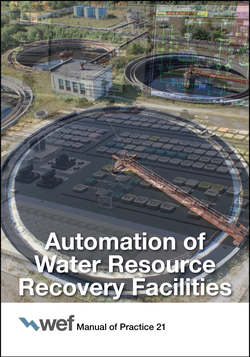Читать книгу Automation of Water Resource Recovery Facilities - Water Environment Federation - Страница 12
2.0 MOTIVATION FOR UPDATING THIS MANUAL
ОглавлениеAlthough the automation field has matured, it is still changing rapidly. In the 2006 edition of this MOP, the following reasons were given for updating the manual; these are still valid today:
• Researchers and practitioners have improved the understanding of physical, chemical, and biological treatment processes and the best strategies to control them;
• Manufacturers have begun creating field instruments and equipment specifically for the wastewater treatment industry (rather than adapting ones made for other industries);
• Field instruments have typically become less expensive, more accurate, easier to calibrate, and sometimes self-diagnosing because of digital electronics, better human interfaces, and other new technologies;
• Networking and wireless (radio) communications have become less expensive, provide more capabilities, and are widely available (e.g., fiber-optic cabling is now common);
• Programmable logic controllers and distributed control systems (DCSs) are smaller, perform better, have more capabilities, and are less expensive;
• “Standardized” PLC-programming tools based on the 1993 International Electrotechnical Commission 1131-3 standards are now used extensively;
• Personal computers operate even faster, have more capacity, are less expensive, and, along with their related software, dominate the automation market;
• Shrink-wrapped, personal computer-based, supervisory control and data acquisition (SCADA) software is now readily available and relatively inexpensive (although it requires extensive configuration);
• Supervisory control and data aquisition systems now typically include monitoring, control, trend, and data features that most users need, and many also include historical data archiving, reporting, fuzzy control (a formal methodology for representing, manipulating, and implementing a human’s heuristic knowledge about how to control a system), artificial neural networks, and model predictive control (a class of controllers that use a model of the process to compute a sequence of manipulated variable adjustments to optimize the future behavior of the process);
• The Internet plays an important role in dispersing information and is evolving into a platform for wide-area control systems; and
• Physical and cyber security have become important issues.
In addition, the following changes have come about since the 2006 edition of this MOP:
• The Department of Homeland Security and other organizations published useful and practical guidelines on cyber security;
• The American National Standards Institute and the International Society of Automation (2009) published excellent guidelines on best practices for alarming;
• Hollifield et al. (2008) provided excellent recommendations on best practices for the HMI;
• Many utilities have developed or plan to develop energy management plans that use their SCADA systems to control energy more effectively; and
• The use of Web-based interfaces has become more common for controllers, individual instruments, and final control elements. In some instances, it is technically possible to access a Web-enabled PLC or instrument via a Web browser (perhaps on a smartphone) from any place on earth that has Internet access. The judicious application of cyber security measures, however, typically precludes such access.
Thirty-four years ago, the authors of the first edition noted that, because automation is a rapidly changing field, the manual would need frequent updates. This is still true today.
